Assessment of Coastal Compound Flooding in Tropical Catchment: Saltwater Creek Catchment in Australia
Abstract
1. Introduction
2. Materials and Methods
2.1. Study Area
2.2. Datasets
2.2.1. Digital Elevation Model (DEM)
2.2.2. Rainfall
2.2.3. Water Level
2.2.4. Tidal Datasets
2.2.5. Hydrological Data
2.2.6. Land Use/Land Cover
2.2.7. Drainage Data
2.2.8. Geology and Soil Type
2.2.9. Climate Change Data
2.3. Method
2.3.1. Rainfall Runoff Model Selection and Setup
2.3.2. Hydrodynamic Model Setup
2.3.3. Rainfall Design Events
2.3.4. Calibration and Validation Event Selection
2.3.5. Model Calibration and Validation
2.3.6. Methods for Uncertainty Reduction
2.3.7. Simulated Scenarios
3. Results
3.1. Hydrological Model Calibration/Validation
3.2. Model Sensitivity Analysis
3.3. Climate Change Impact on Hydrology
3.4. Hydrodynamic Model Result
3.4.1. Inundation Depth
3.4.2. Velocity Alterations
4. Discussion
4.1. Modelling Performance Results
4.2. Compounding Modelling: Philosophical to Practical Approach
4.3. Compounding Effects
4.4. Implication of Compound Flooding
5. Limitations of the Study
6. Conclusions
Author Contributions
Funding
Data Availability Statement
Acknowledgments
Conflicts of Interest
Abbreviations
| Abbreviations | Meanings |
| SLR | Sea Level Rise |
| WSUD | Water-Sensitive Urban Design |
| AEP | Annual Exceedance Probability |
| 1D | One-Dimensional |
| 2D | Two-Dimensional |
| PF | Peak Flow |
| TRV | Total Runoff Volume |
| IPCC | Intergovernmental Panel on Climate Change |
| AHD | Australian Height Datum |
| CRC | Cairns Regional Council |
| BOM | Australian Bureau of Meteorology |
| DEM | Digital Elevation Model |
| IDW | Inverse Distance Weighting |
| ARR | Australian Rainfall and Runoff |
| ATP | Areal Temporal Pattern |
| ARF | Areal Reduction Factor |
| IFD | Intensity–Frequency–Duration |
| RORB | Runoff Routing |
| DHI | Danish Hydraulic Institute |
| CS | Collection System |
| GIS | Geographic Information System |
| QGIS | Quantum Geographic Information System |
| NSE | Nash–Sutcliffe Efficiency |
| RMSE | Root Mean Square Error |
| PBIAS | Percentage Bias |
| RSR | Ratio of the Root Mean Square Error to the Standard Deviation |
| EIA | Effective Impervious Area |
| FEA | Flood Extent Area |
| CA | Catchment Area |
| MWL | Maximum Water Level |
| IL | Initial Loss |
| CL | Continuous Loss |
| WBNM | Watershed Bounded Network Model |
| URBS | Unified River Basin Simulator |
| HEC-HMS | Hydrologic Engineering Centre Hydrologic Modelling System |
| XP-RAFTS | XP Rainfall Runoff Analysis Forecasting Tool for Stormwater |
| RCPs | Representative Concentration Pathways |
| DCIA | Directly Connected Impervious Area |
| ICIA | Indirectly Connected Impervious Area |
| TIA | Total Impervious Area |
| ICCF | Interim Climate Change Factor |
| CC | Current Climate |
References
- Allaire, M. Socio-economic impacts of flooding: A review of the empirical literature. Water Secur. 2018, 3, 18–26. [Google Scholar] [CrossRef]
- Dottori, F.; Szewczyk, W.; Ciscar, J.C.; Zhao, F.; Alfieri, L.; Hirabayashi, Y.; Bianchi, A.; Mongelli, I.; Frieler, K.; Betts, R.A.; et al. Increased human and economic losses from river flooding with anthropogenic warming. Nat. Clim. Change 2018, 8, 781–786. [Google Scholar] [CrossRef]
- Kirezci, E.; Young, I.R.; Ranasinghe, R.; Lincke, D.; Hinkel, J. Global-scale analysis of socioeconomic impacts of coastal flooding over the 21st century. Front. Mar. Sci. 2023, 9, 1024111. [Google Scholar] [CrossRef]
- IPCC. Climate Change 2021: The Physical Science Basis Summary for Policymakers; IPCC: Geneva, Switzerland, 2021; pp. 1–42. [Google Scholar]
- Hooijer, A.; Vernimmen, R. Global LiDAR land elevation data reveal greatest sea-level rise vulnerability in the tropics. Nat. Commun. 2021, 12, 3592. [Google Scholar] [CrossRef]
- Storch, H.; Downes, N.K. A scenario-based approach to assess Ho Chi Minh City’s urban development strategies against the impact of climate change. Cities 2011, 28, 517–526. [Google Scholar] [CrossRef]
- Zhang, Y.; Najafi, M.R. Probabilistic Numerical Modeling of Compound Flooding Caused by Tropical Storm Matthew Over a Data-Scarce Coastal Environment. Water Resour. Res. 2020, 56, e2020WR028565. [Google Scholar] [CrossRef]
- Green, J.; Haigh, I.D.; Quinn, N.; Neal, J.; Wahl, T.; Wood, M.; Eilander, D.; de Ruiter, M.; Ward, P.; Camus, P. Review article: A comprehensive review of compound flooding literature with a focus on coastal and estuarine regions. Nat. Hazards Earth Syst. Sci. 2025, 25, 747–816. [Google Scholar] [CrossRef]
- Ghanbari, M.; Arabi, M.; Kao, S.C.; Obeysekera, J.; Sweet, W. Climate Change and Changes in Compound Coastal-Riverine Flooding Hazard Along the U.S. Coasts. Earth’s Future 2021, 9, e2021EF002055. [Google Scholar] [CrossRef]
- Mu, D.; Luo, P.; Lyu, J.; Zhou, M.; Huo, A.; Duan, W.; Nover, D.; He, B.; Zhao, X. Impact of temporal rainfall patterns on flash floods in Hue City, Vietnam. J. Flood Risk Manag. 2021, 14, e12668. [Google Scholar] [CrossRef]
- Patel, P.; Karmakar, S.; Ghosh, S.; Aliaga, D.G.; Niyogi, D. Impact of green roofs on heavy rainfall in tropical, coastal urban area. Environ. Res. Lett. 2021, 16, 074051. [Google Scholar] [CrossRef]
- Wijetunge, J.J.; Neluwala, N.G.P.B. Compound flood hazard assessment and analysis due to tropical cyclone-induced storm surges, waves and precipitation: A case study for coastal lowlands of Kelani river basin in Sri Lanka. Nat. Hazards 2023, 116, 3979–4007. [Google Scholar] [CrossRef]
- Ganguli, P.; Lin, N. Intense humid heat—Tropical cyclone compound hazards in eastern coastal India. npj Nat. Hazards 2025, 2, 49. [Google Scholar] [CrossRef]
- Bevacqua, E.; Vousdoukas, M.I.; Zappa, G.; Hodges, K.; Shepherd, T.G.; Maraun, D.; Mentaschi, L.; Feyen, L. More meteorological events that drive compound coastal flooding are projected under climate change. Commun. Earth Environ. 2020, 1, 47. [Google Scholar] [CrossRef]
- Gori, A.; Lin, N.; Smith, J. Assessing Compound Flooding From Landfalling Tropical Cyclones on the North Carolina Coast. Water Resour. Res. 2020, 56, e2019WR026788. [Google Scholar] [CrossRef]
- Koochaksarali, H.B. Compound Flooding in Coastal Areas Emanating From Inland and Offshore Events. Ph.D. Thesis, New Jersey Institute of Technology, Newark, NJ, USA, 2020. [Google Scholar]
- Leijnse, T.; van Ormondt, M.; Nederhoff, K.; van Dongeren, A. Modelling compound flooding in coastal systems using a computationally efficient reduced-physics solver: Including fluvial, pluvial, tidal, wind- and wave-driven processes. Coast. Eng. 2021, 163, 103796. [Google Scholar] [CrossRef]
- Moftakhari, H.R.; Salvadori, G.; AghaKouchak, A.; Sanders, B.F.; Matthew, R.A. Compounding effects of sea level rise and fluvial flooding. Proc. Natl. Acad. Sci. USA 2017, 114, 9785–9790. [Google Scholar] [CrossRef] [PubMed]
- Drews, M.; Schröter, K.; Wortmann, M.; Larsen, M.A.D. Compound Risk of Extreme Pluvial and Fluvial Floods. In Proceedings of the EGU General Assembly, Online, 4–8 May 2020. [Google Scholar] [CrossRef]
- Santiago-Collazo, F.L.; Bilskie, M.V.; Hagen, S.C. A comprehensive review of compound inundation models in low-gradient coastal watersheds. Environ. Model. Softw. 2019, 119, 166–181. [Google Scholar] [CrossRef]
- Thieken, A.H.; Samprogna Mohor, G.; Kreibich, H.; Müller, M. Compound inland flood events: Different pathways, different impacts and different coping options. Nat. Hazards Earth Syst. Sci. 2022, 22, 165–185. [Google Scholar] [CrossRef]
- Bisht, D.S.; Chatterjee, C.; Kalakoti, S.; Upadhyay, P.; Sahoo, M.; Panda, A. Modeling urban floods and drainage using SWMM and MIKE URBAN: A case study. Nat. Hazards 2016, 84, 749–776. [Google Scholar] [CrossRef]
- Echogdali, F.Z.; Boutaleb, S.; Kpan, R.B.; Ouchchen, M.; Id-Belqas, M.; Dadi, B.; Ikirri, M.; Abioui, M. Flood hazard and susceptibility assessment in a semi-arid environment: A case study of Seyad basin, south of Morocco. J. Afr. Earth Sci. 2022, 196, 104709. [Google Scholar] [CrossRef]
- Surendar Natarajan, N.R. An Integrated Hydrologic and Hydraulic Flood Modeling Study for a Medium-Sized Ungauged Urban Catchment Area: A Case Study of Tiruchirappalli City Using HEC-HMS and HEC-RAS. J. Inst. Eng. India Ser. A 2020, 101, 381–398. [Google Scholar] [CrossRef]
- Namara, W.G.; Damisse, T.A.; Tufa, F.G. Application of HEC-RAS and HEC-GeoRAS model for Flood Inundation Mapping, the case of Awash Bello Flood Plain, Upper Awash River Basin, Oromiya Regional State, Ethiopia. Model. Earth Syst. Environ. 2022, 8, 1449–1460. [Google Scholar] [CrossRef]
- Ridder, N.N.; Pitman, A.J.; Westra, S.; Ukkola, A.; Hong, X.D.; Bador, M.; Hirsch, A.L.; Evans, J.P.; Di Luca, A.; Zscheischler, J. Global hotspots for the occurrence of compound events. Nat. Commun. 2020, 11, 5956. [Google Scholar] [CrossRef] [PubMed]
- Wu, G.; Liu, Q.; Xu, H.; Wang, J. Modelling the combined impact of sea level rise, land subsidence, and tropical cyclones in compound flooding of coastal cities. Ocean. Coast. Manag. 2024, 252, 107107. [Google Scholar] [CrossRef]
- Monthly Climate Statistics. Available online: http://www.bom.gov.au/climate/averages/tables/cw_031011.shtml (accessed on 12 August 2023).
- Available online: https://www.data.qld.gov.au/dataset/cairns-tide-gauge-predicted-interval-data (accessed on 8 December 2023).
- Brown, I.W.; McDougall, K.; Alam, M.J.; Chowdhury, R.; Chadalavada, S. Calibration of a continuous hydrologic simulation model in the urban Gowrie Creek catchment in Toowoomba, Australia. J. Hydrol. Reg. Stud. 2022, 40, 101021. [Google Scholar] [CrossRef]
- Powell, L.; Lim, H.; Brown, I.; Huang, T.; Munksgaard, N.C.; Randall, M.; Holdsworth, J.; Cook, H. Innovation Through Collaboration: Improving urban water management for a reef council. Water e-J. 2020, 5, 1–10. [Google Scholar] [CrossRef]
- Available online: https://www.swoffer.com/ (accessed on 8 September 2023).
- Loveridge, M.; Babister, M.; Retallick, M. Australian Rainfall and Runoff Revision Project 3: Temporal Patterns of Rainfall—Stage 3 Report; WMA Water: Sydney NSW, Australia, 2015; p. 62. [Google Scholar]
- Available online: https://qldglobe.information.qld.gov.au/ (accessed on 8 December 2024).
- Boyd, M.J.; Bufill, M.C.; Knee, R.M. Pervious and impervious runoff in urban catchments. Hydrol. Sci. J. 1993, 38, 463–478. [Google Scholar] [CrossRef]
- Ebrahimian, A.; Wilson, B.N.; Gulliver, J.S. Improved methods to estimate the effective impervious area in urban catchments using rainfall-runoff data. J. Hydrol. 2016, 536, 109–118. [Google Scholar] [CrossRef]
- Chang, T.-J.; Wang, C.-H.; Chen, A.S.; Djordjević, S. The effect of inclusion of inlets in dual drainage modelling. J. Hydrol. 2018, 59, 541–555. [Google Scholar] [CrossRef]
- Available online: https://geoscience.data.qld.gov.au/data/map-collection/mr002086 (accessed on 16 October 2023).
- Available online: https://www.longpaddock.qld.gov.au/qld-future-climate/dashboard/#responseTab1 (accessed on 10 November 2023).
- Gurung, S.B.; Wasson, R.J.; Bird, M.; Jarihani, B. Impact of Climate Change on Water-Sensitive Urban Design Performances on Mitigating Urban Flooding in the Wet Tropical Queensland Sub-Catchment. Earth 2025, 6, 99. [Google Scholar] [CrossRef]
- Available online: https://harc.com.au/software/rorb/ (accessed on 5 August 2023).
- Laurenson, E.M.; Mein, R.G.; Nathan, R.J. User Manual of RORB Runoff Routing Program, Version 6; Department of Civil Engineering, Monash University: Melbourne, Australia, 2010. [Google Scholar]
- MIKE 2022 MIKE+ User Guide Model Manager; Danish Hydraulic Institute (DHI): Hørsholm, Denmark, 2022.
- MIKE Flood 1D-2D Modelling User Manual; Danish Hydraulic Institute (DHI): Hørsholm, Denmark,, 2017; pp. 1–160.
- Available online: https://www.dhigroup.com (accessed on 6 June 2022).
- Haghighatafshar, S.; Nordlöf, B.; Roldin, M.; Gustafsson, L.G.; la Cour Jansen, J.; Jönsson, K. Efficiency of blue-green stormwater retrofits for flood mitigation—Conclusions drawn from a case study in Malmö, Sweden. J. Environ. Manag. 2018, 207, 60–69. [Google Scholar] [CrossRef]
- Available online: https://csse.com.au/index.php/products/storm-injector (accessed on 8 August 2023).
- Ball, J.E.; Babister, M.K.; Nathan, R.; Weinmann, P.E.; Weeks, W.; Retallick, M.; Testoni, I. A Guide to Flood Estimation—A Guide to Flood Estimation Book; Geoscience Australia: Symonston, ACT, Australia, 2019; p. 187, IBSN 9781925848366. [Google Scholar]
- Althoff, D.; Rodrigues, L.N. Goodness-of-fit criteria for hydrological models: Model calibration and performance assessment. J. Hydrol. 2021, 600, 126674. [Google Scholar] [CrossRef]
- Liang, H.; Zhou, X. Impact of Tides and Surges on Fluvial Floods in Coastal Regions. Remote Sens. 2022, 14, 5779. [Google Scholar] [CrossRef]
- Available online: https://floodcheck.information.qld.gov.au/ (accessed on 12 August 2023).
- Harrison, A.J.; Carley, J.T.; Coghlan, I.R.; Drummond, C.D. Methodology for Modelling Dynamic Coastal Tailwater Levels. In Proceedings of the Australasian Coasts & Ports 2019 Conference, Hobart, Australia, 10–13 September 2019. [Google Scholar]
- Seneviratne, S.I.; Zhang, X.; Adnan, M.; Badi, W.; Dereczynski, C.; Di Luca, A.; Ghosh, S.; Iskandar, I.; Kossin, J.; Lewis, S.; et al. Chapter 11: Weather and Climate Extreme Events in a Changing Climate:The Physical Science Basis; Cambridge University Press: Cambridge, UK; New York, NY, USA, 2021; pp. 1513–1766. [Google Scholar]
- Zheng, F.; Westra, S.; Leonard, M. Revision Project 18: Coincidence of Fluvial Flooding Events and Coastal Water Levels in Estuarine Areas; Engineers Australia: Adelaide SA, USA, The University of Adelaide: Adelaide SA, USA; 2014. [Google Scholar]
- Westra, S. Revision Project 18: Interaction of Coastal Processes and Severe Weather Events; Stage 2 Report; Engineers Australia/Water Engineering: Adelaide SA, USA, 2012. [Google Scholar]
- SEPA. Flood Modelling Guidance for Responsible Authorities, Version 1.1; Scottish Environment Protection Agency: Stirling, UK, 2017. [Google Scholar]
- Couasnon, A.; Eilander, D.; Muis, S.; Veldkamp, T.I.E.; Haigh, I.D.; Wahl, T.; Winsemius, H.C.; Ward, P.J. Measuring compound flood potential from river discharge and storm surge extremes at the global scale. Nat. Hazards Earth Syst. Sci. 2020, 20, 489–504. [Google Scholar] [CrossRef]
- Bevacqua, E.; De Michele, C.; Manning, C.; Couasnon, A.; Ribeiro, A.F.S.; Ramos, A.M.; Vignotto, E.; Bastos, A.; Blesić, S.; Durante, F.; et al. Guidelines for Studying Diverse Types of Compound Weather and Climate Events. Earth’s Future 2021, 9, e2021EF002340. [Google Scholar] [CrossRef]
- Xu, H.; Tian, Z.; Sun, L.; Ye, Q.; Ragno, E.; Bricker, J.; Mao, G.; Tan, J.; Wang, J.; Ke, Q.; et al. Compound flood impact of water level and rainfall during tropical cyclone periods in a coastal city: The case of Shanghai. Nat. Hazards Earth Syst. Sci. 2022, 22, 2347–2358. [Google Scholar] [CrossRef]
- Emanuele Bevacqua, D.M.; Haff, I.H.; Widmann, M.; Vrac, M. Multivariate statistical modelling of compound events via pair-copula constructions: Analysis of floods in Ravenna (Italy). Hydrol. Earth Syst. Sci. 2017, 21, 2701–2723. [Google Scholar] [CrossRef]
- Wahl, T.; Jain, S.; Bender, J.; Meyers, S.D.; Luther, M.E. Increasing risk of compound flooding from storm surge and rainfall for major US cities. Nat. Clim. Chang. 2015, 5, 1093–1097. [Google Scholar] [CrossRef]
- Kreibich, H.; Piroth, K.; Seifert, I.; Maiwald, H.; Kunert, U.; Schwarz, J.; Merz, B.; Thieken, A.H. Is flow velocity a significant parameter in flood damage modelling? Nat. Hazards Earth Syst. Sci. 2009, 9, 1679–1692. [Google Scholar] [CrossRef]
- Ball, J.E.; Babister, M.K.; Nathan, R.; Weinmann, P.E.; Weeks, W.; Retallick, M.; Testoni, I. Australian Rainfall & Runoff Book 1: A Guide to Flood Estimation; Australian Government: Canberra, Australia, 2019. [Google Scholar]
- Coombes, P.; Roso, S. A Guide To Flood Estimation: Book 9 Runoff in Urban Areas; Commonwealth of Australia (Geoscience Australia): Symonston, ACT, Australia, 2019; p. 184. [Google Scholar]
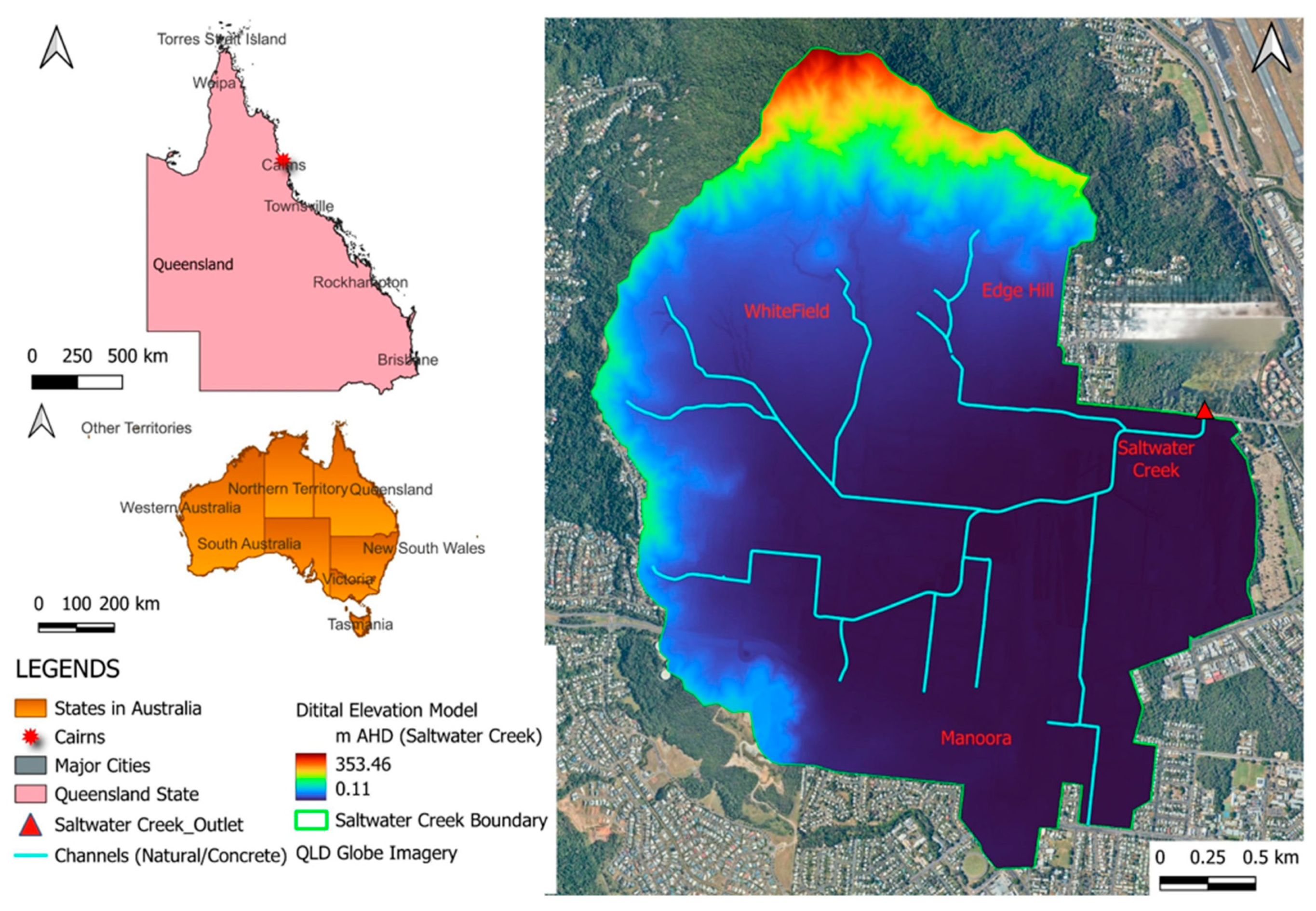
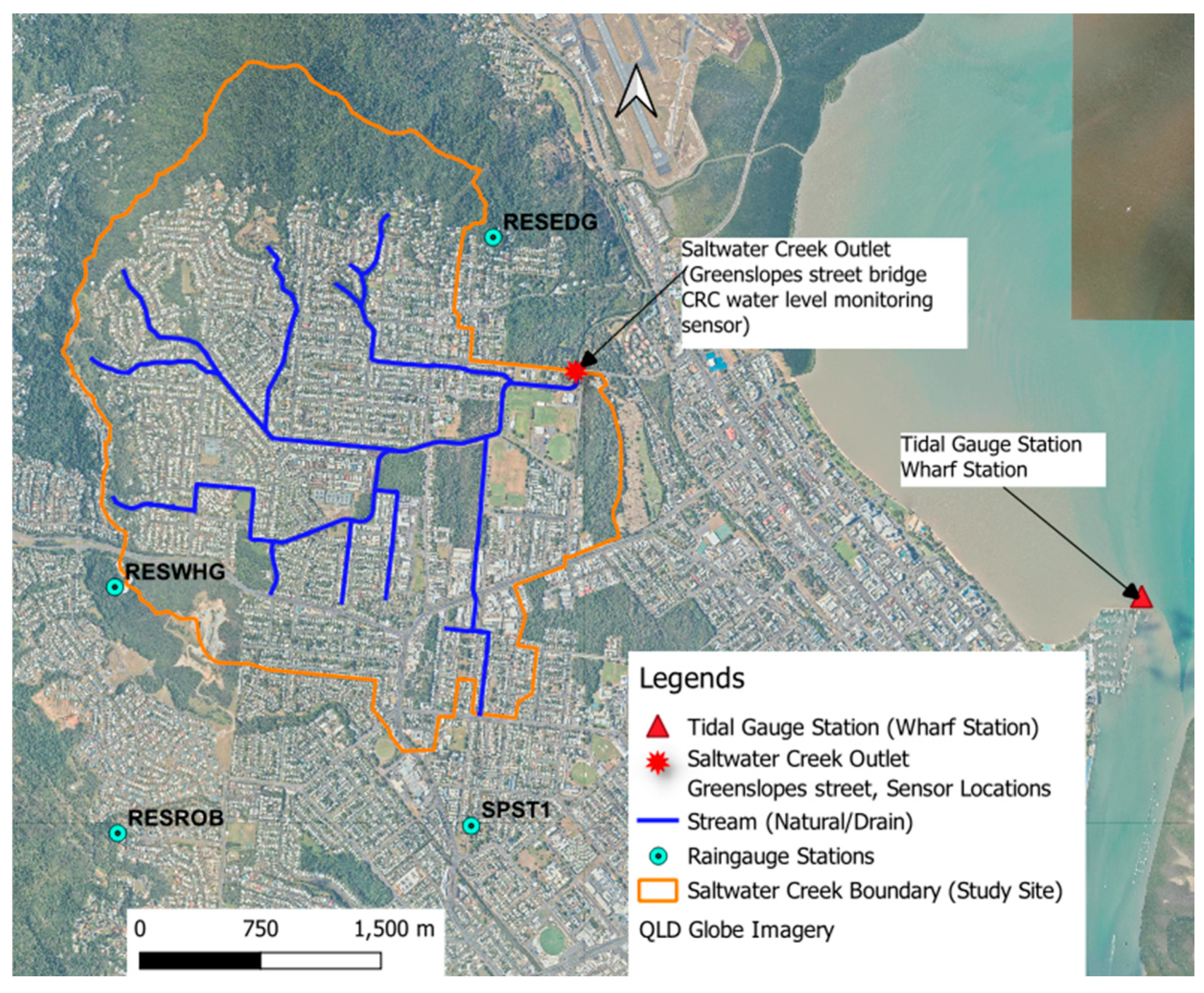


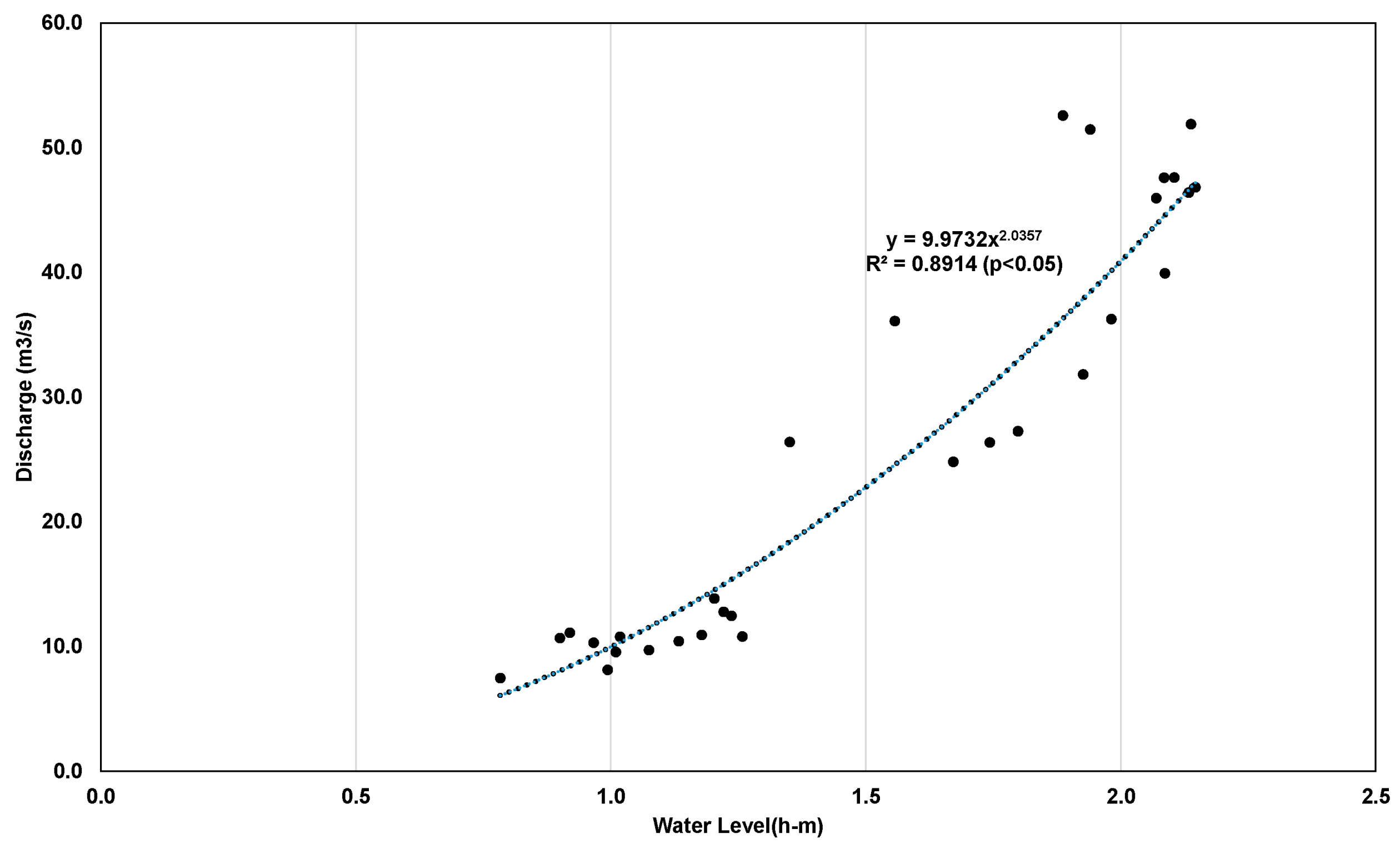
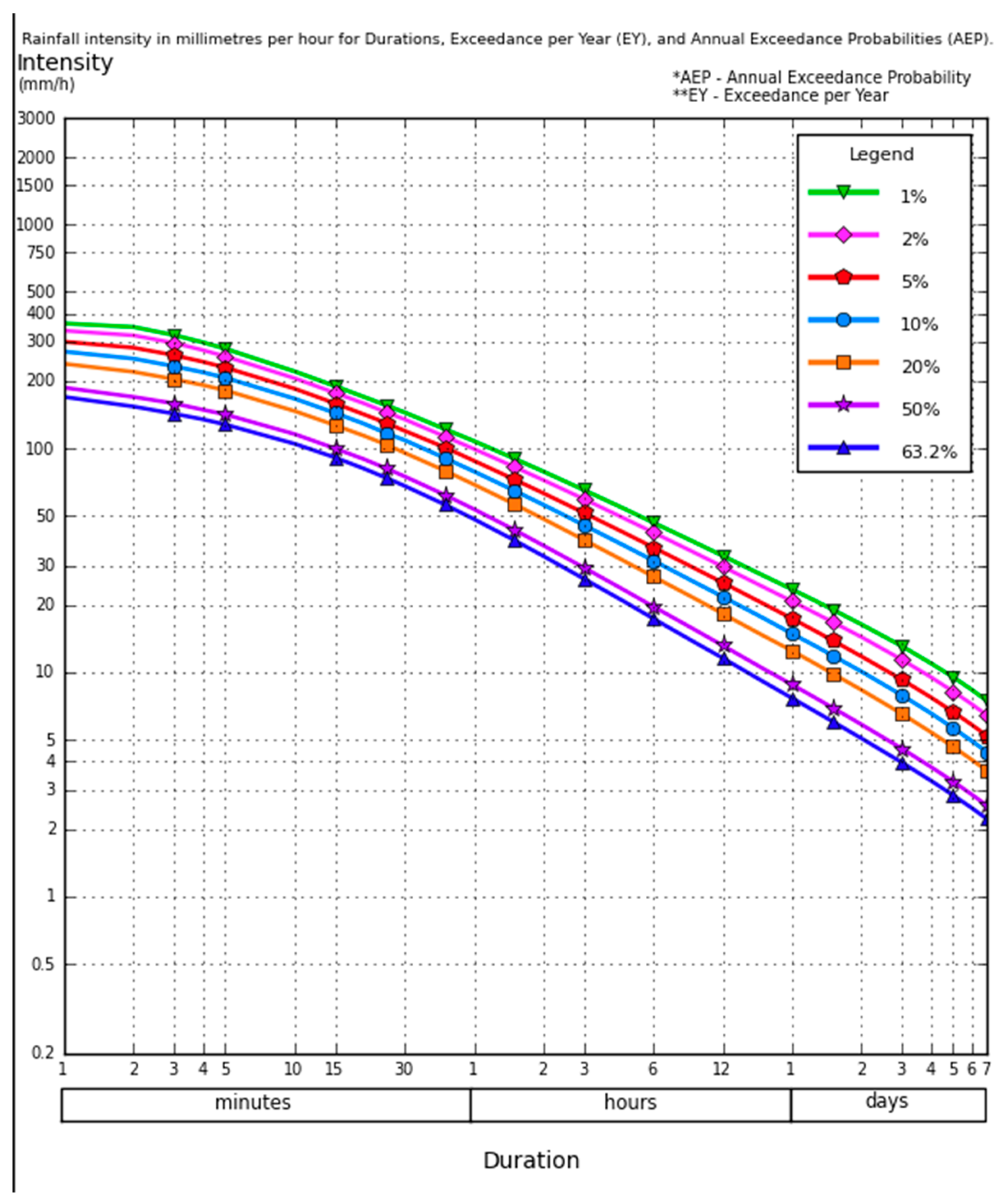
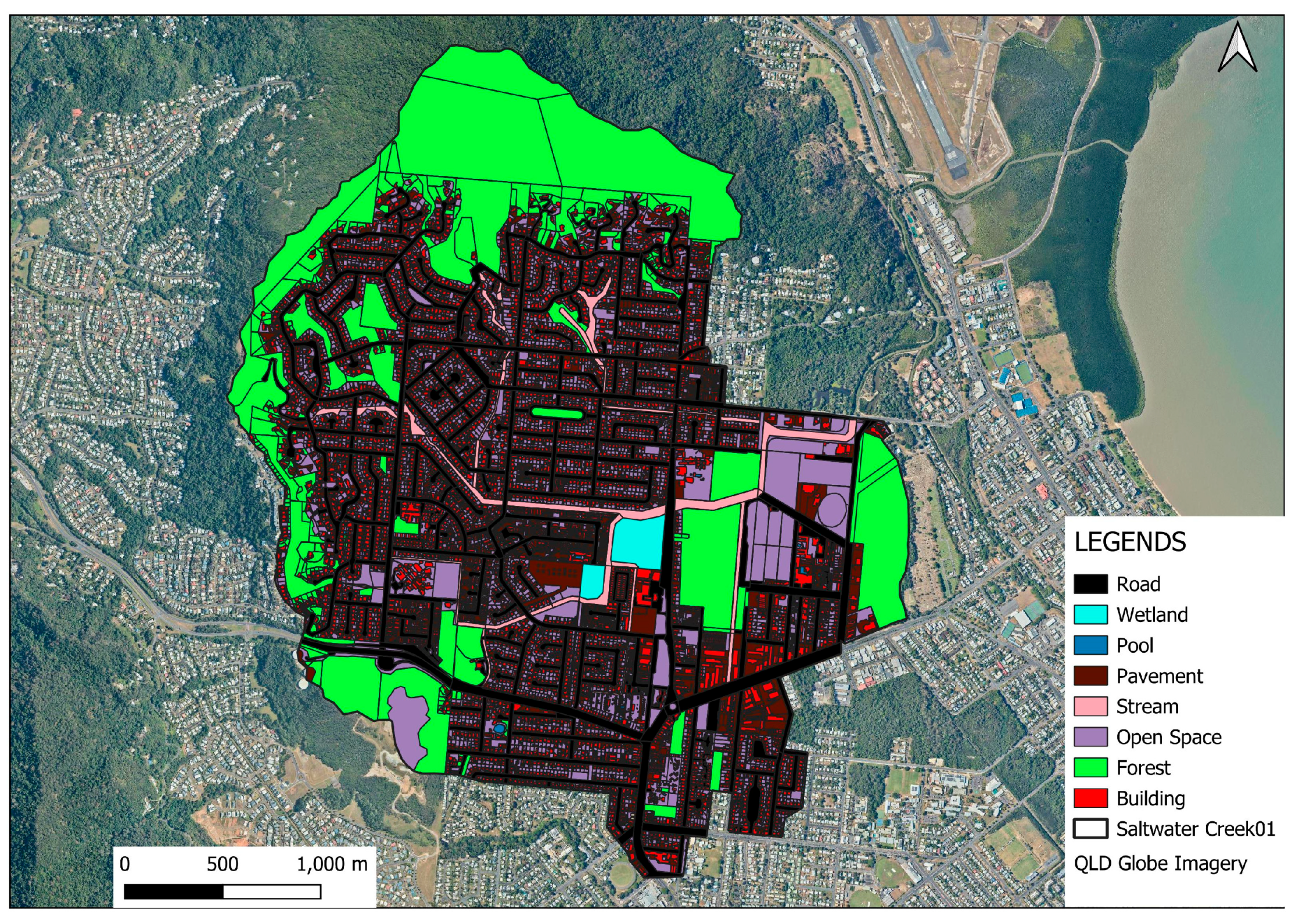
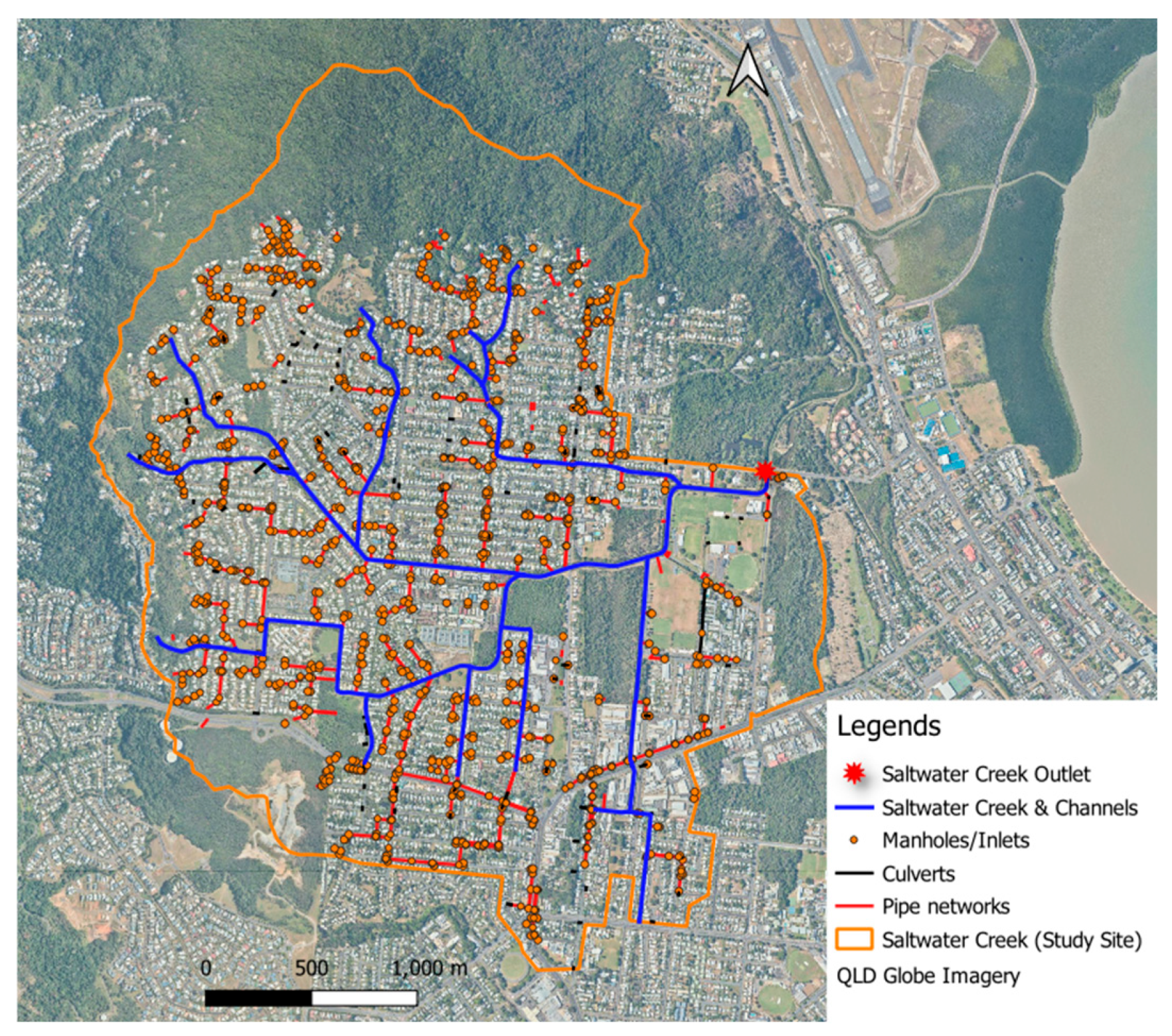
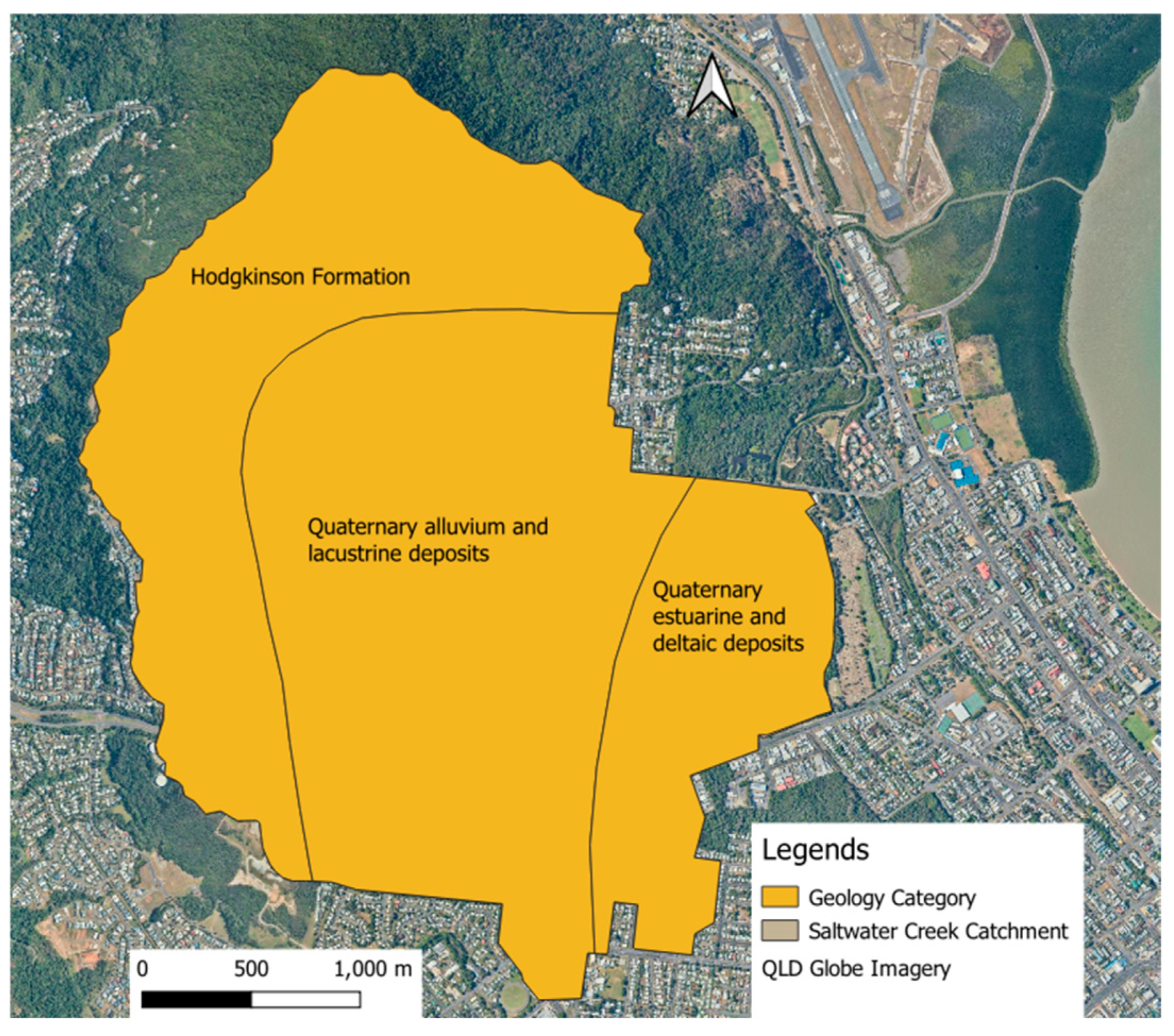
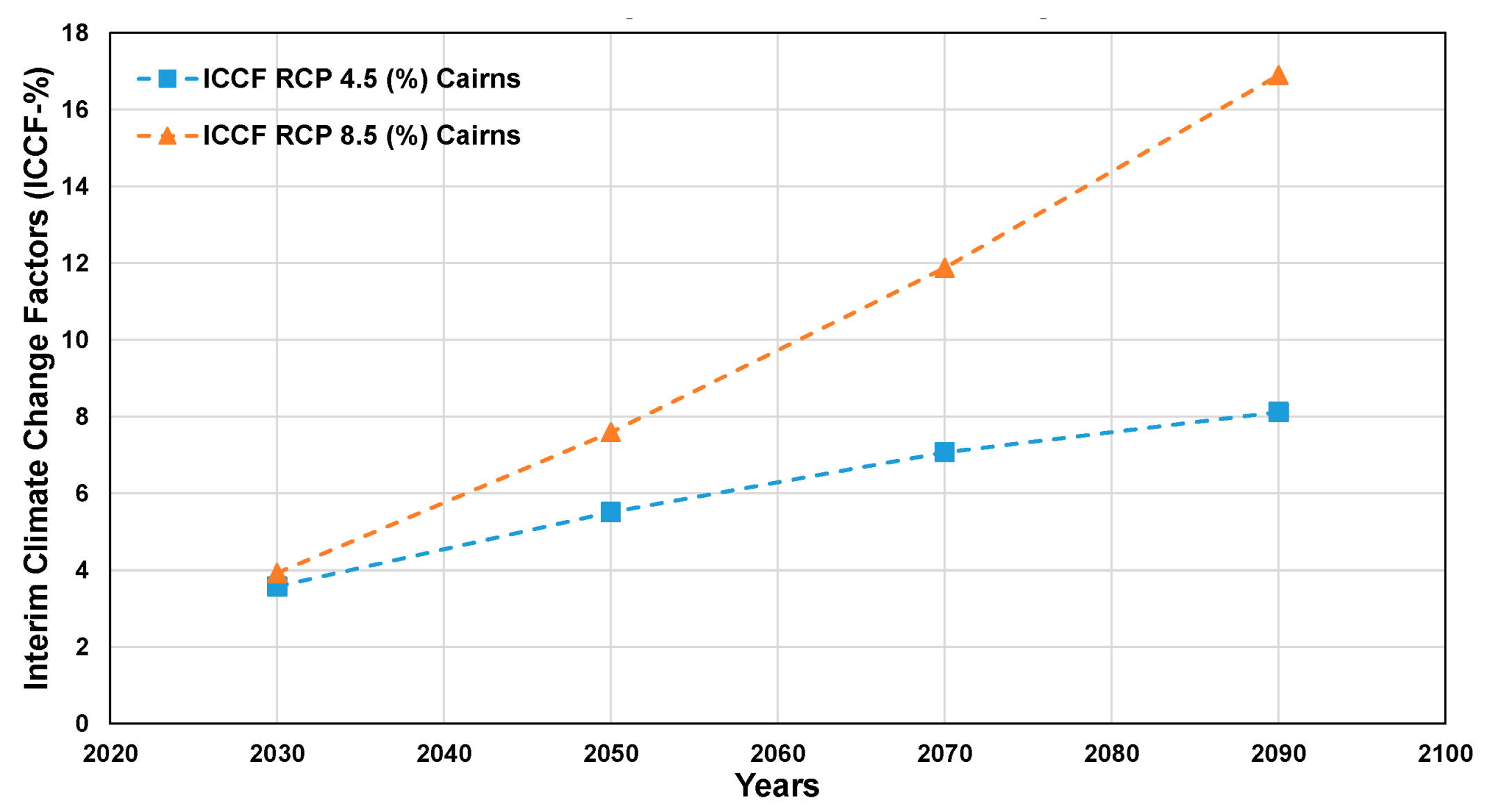
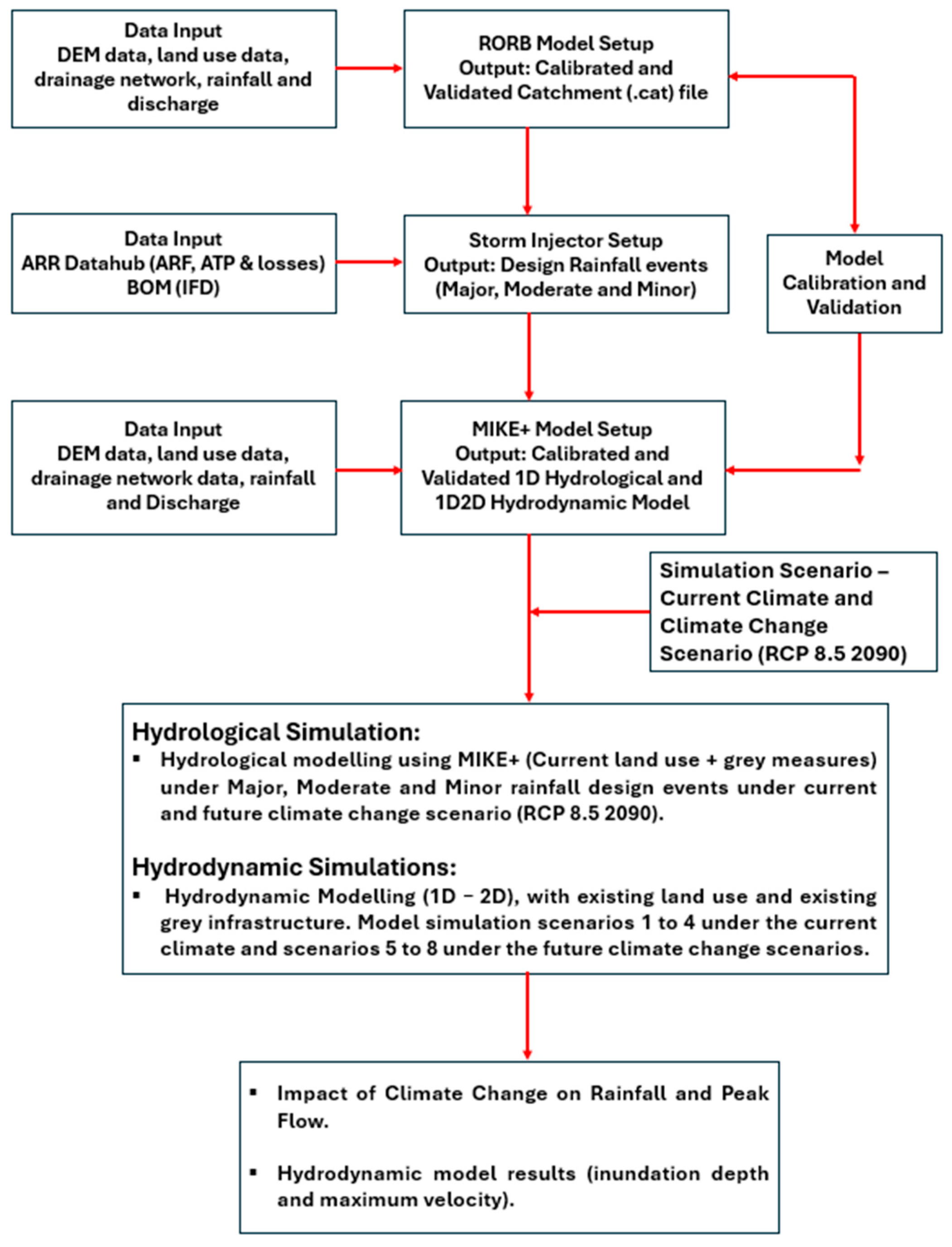
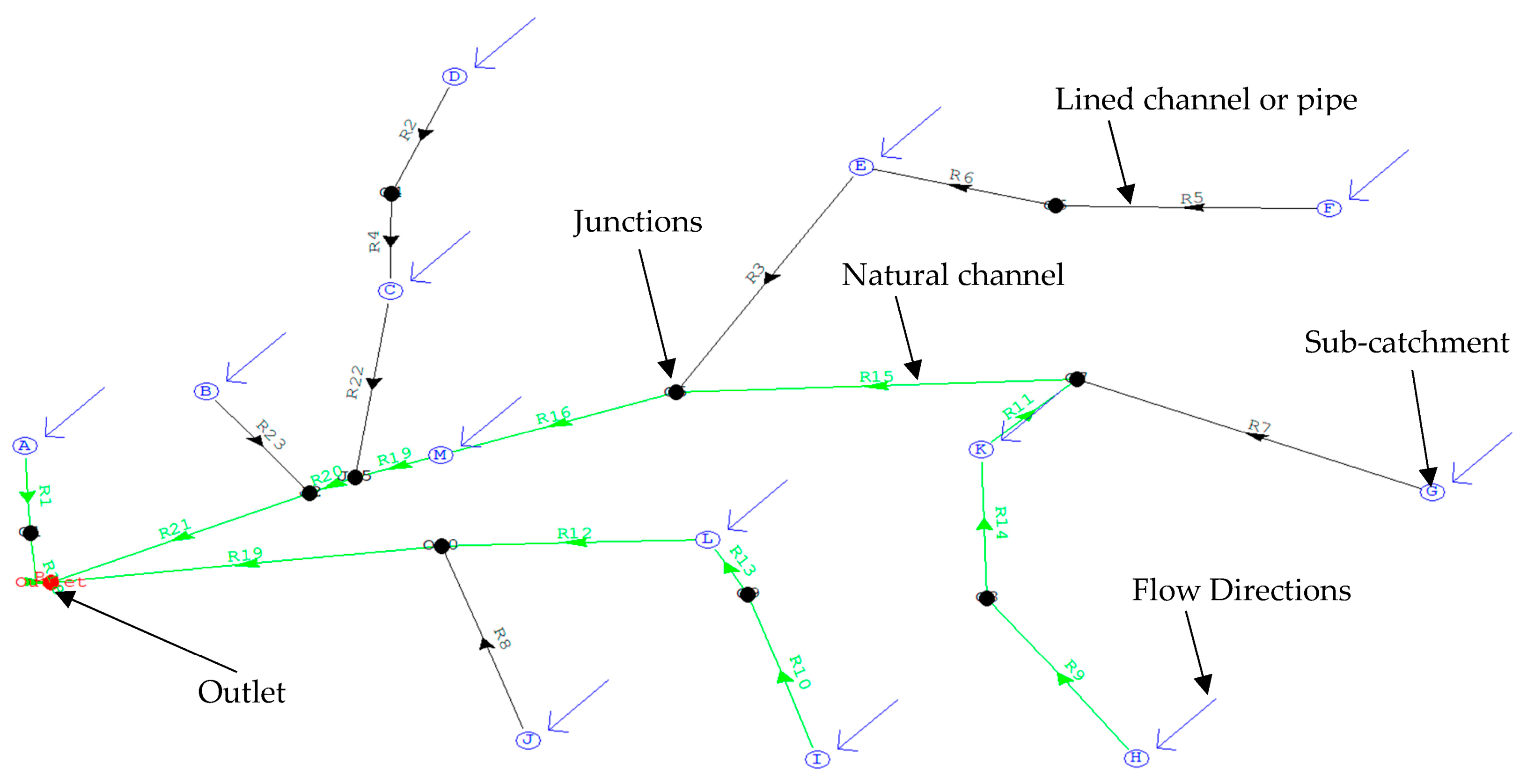
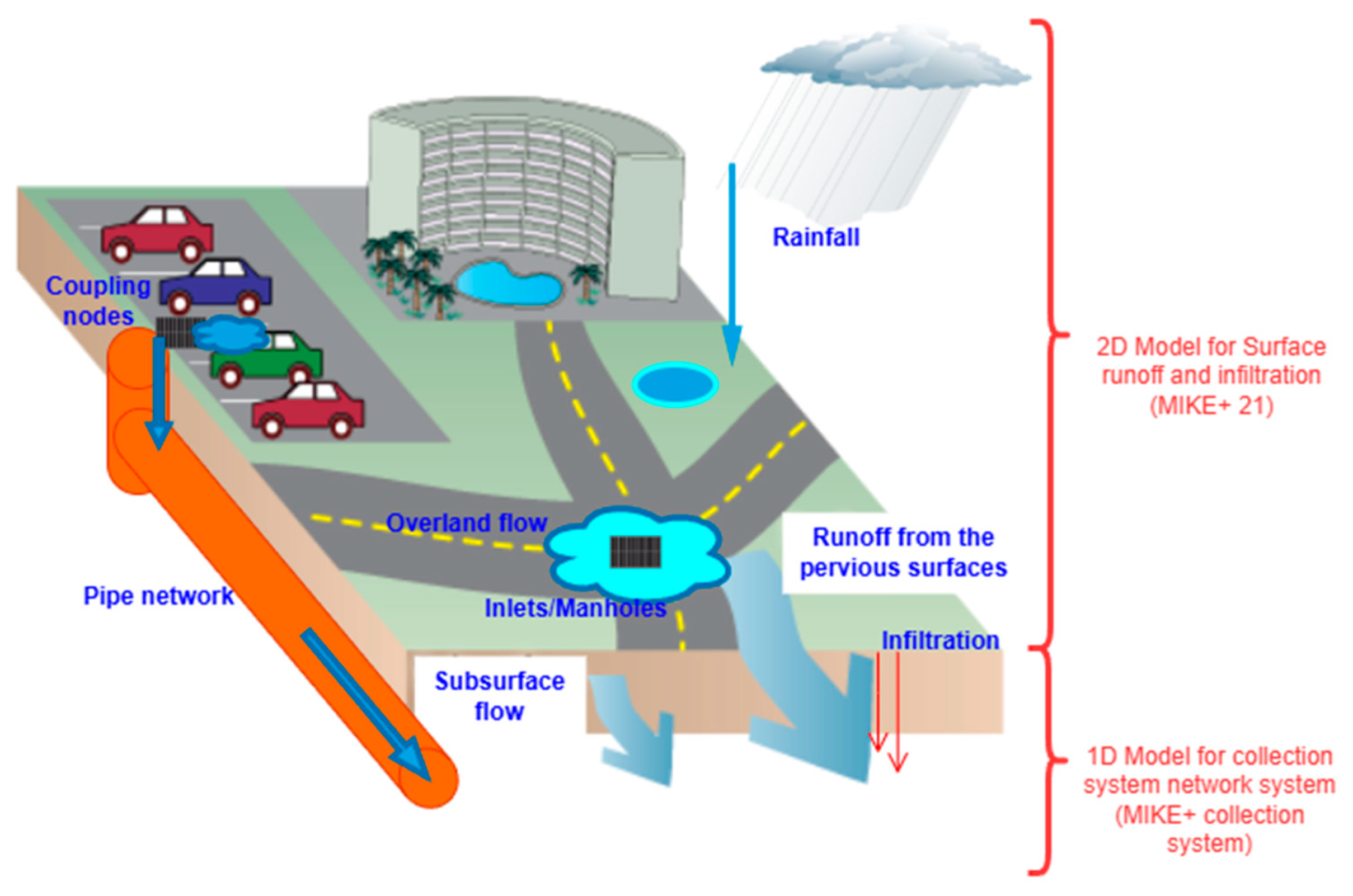
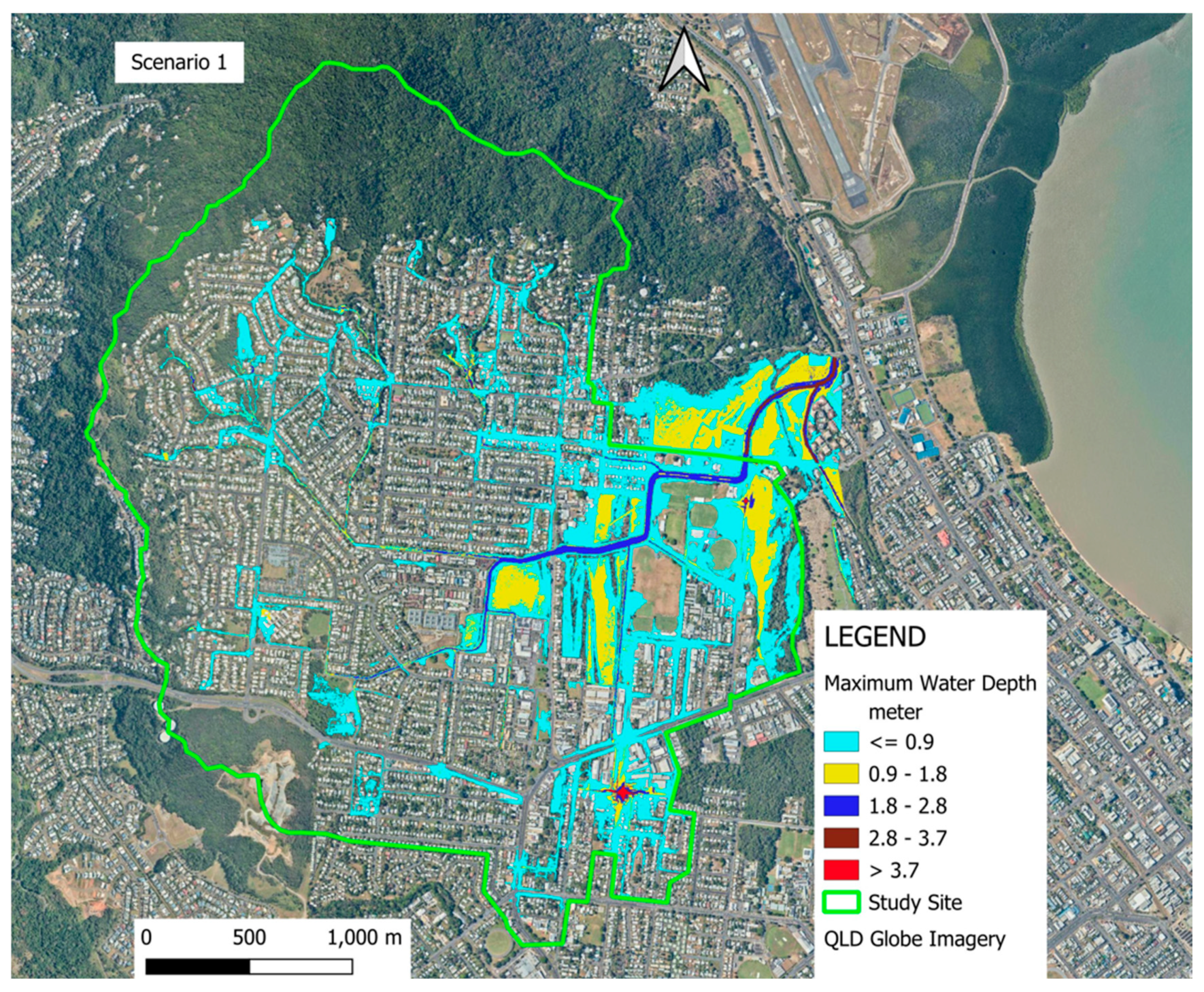

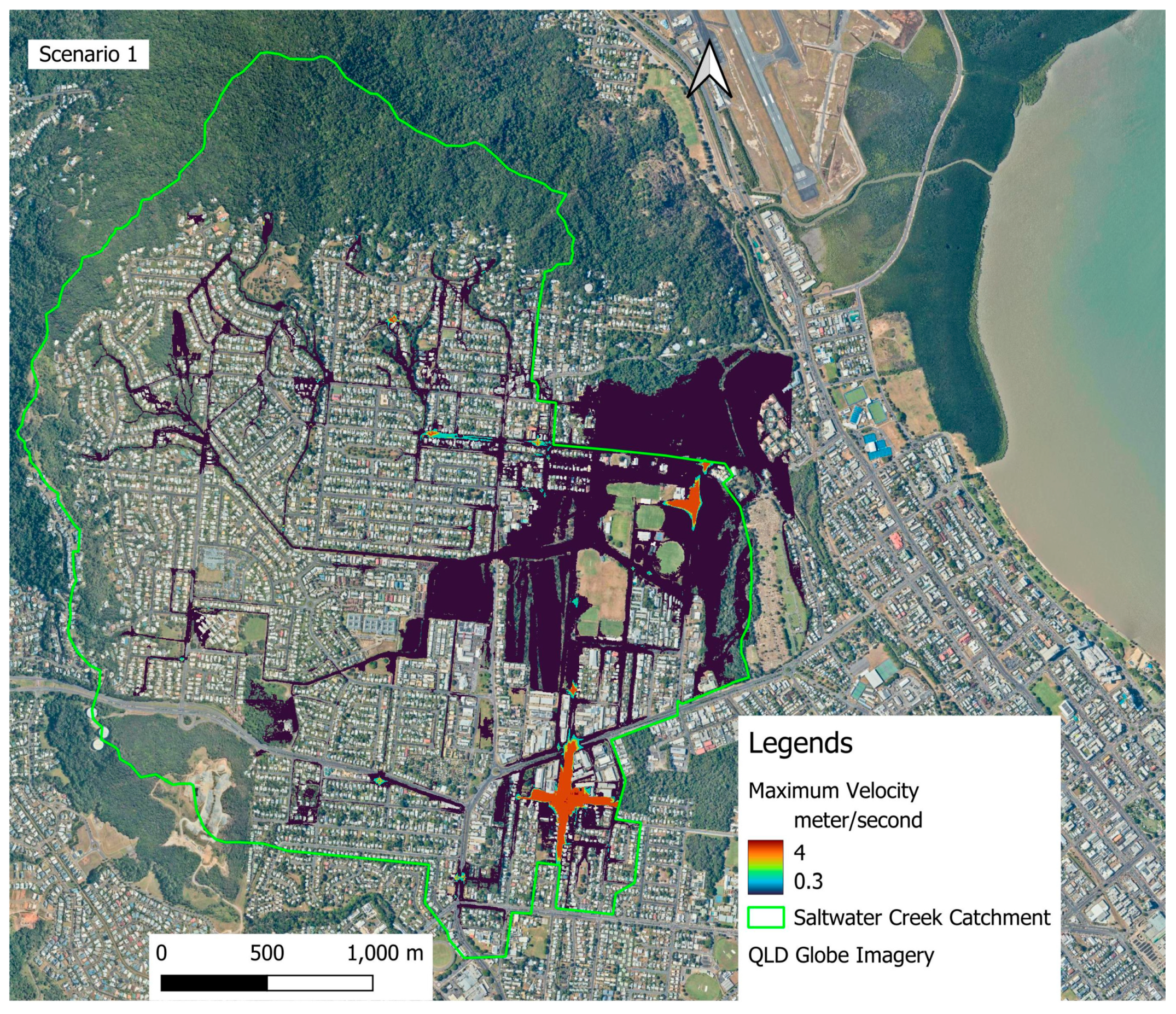
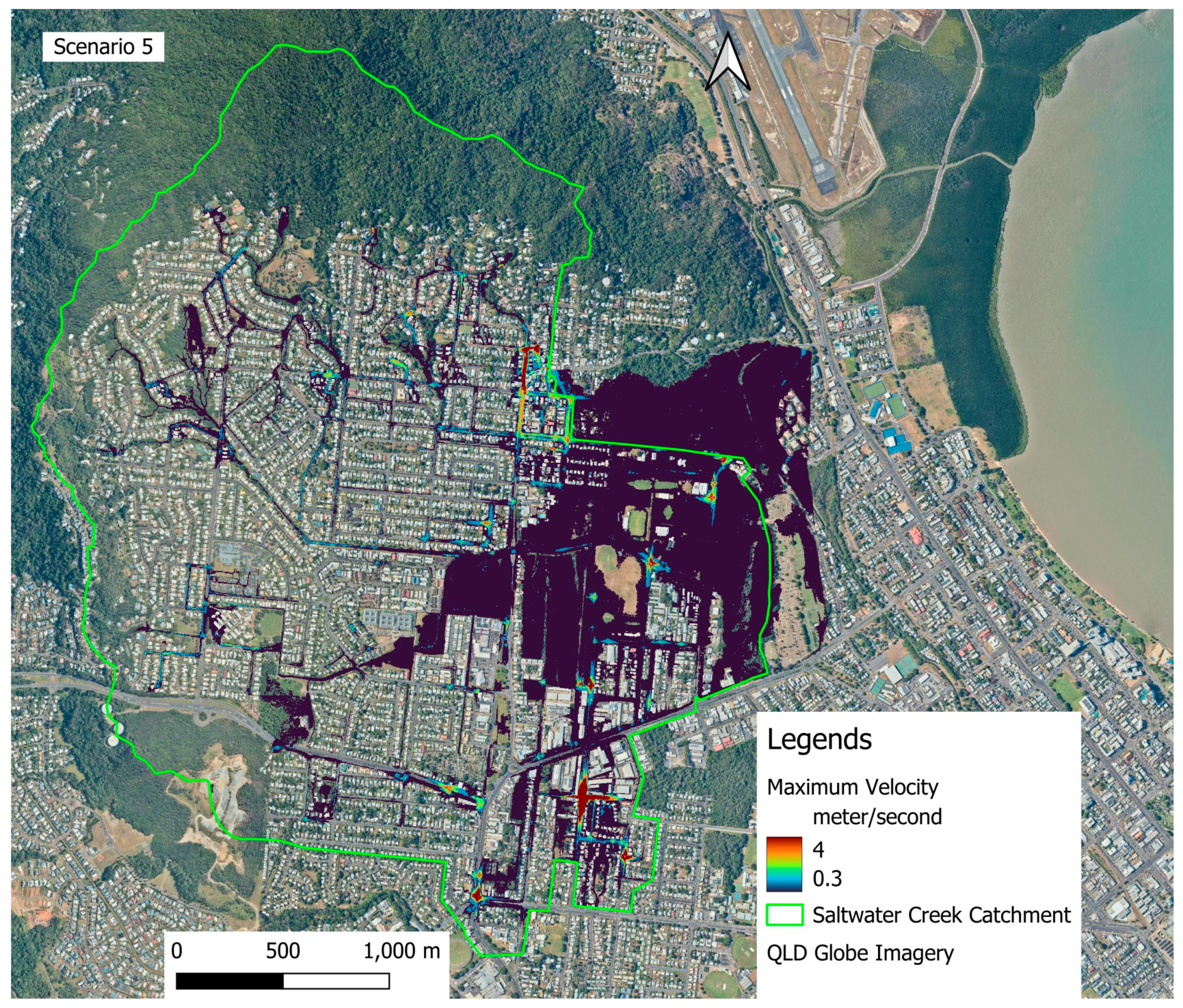
| Events | Types | Rainfall Depth (mm) | Rainfall Duration (Hours) | Peak Flow (m3/s) | Remarks |
|---|---|---|---|---|---|
| Calibration Events | |||||
| 29 January 2020 | Major | 154 | 21 | 46 | |
| 17 December 2023 | Major | 472 | 81 | 56 | Tropical Cyclone Jasper, 13–18 December 2023 |
| 4 April 2019 | Moderate | 138 | 30 | 30 | |
| 13 January 2024 | Moderate | 71 | 17 | 24 | |
| 28 January 2020 | Minor | 32 | 16 | 9 | |
| 27 February 2020 | Minor | 59 | 15 | 18 | |
| Validation Events | |||||
| 24 March 2021 | Major | 110 | 24 | 51 | Tropical Cyclone Niran |
| 25 February 2020 | Moderate | 57 | 14 | 29 | |
| 22 February 2020 | Minor | 56 | 14 | 16 | |
| Scenario | Description |
|---|---|
| Hydrological Simulation Scenarios | |
| Rainfall | Major, moderate, and minor |
| Climate Change | Current climate (CC) and RCP 8.5 |
| Hydrodynamic Simulation Scenarios | |
| Scenario 1 (S1) | Major rainfall design event under CC + high astronomical event time series (measured tidal time series) |
| Scenario 2 (S2) | Major rainfall design event under CC + minor tidal level (measured tidal time series) |
| Scenario 3 (S3) | Moderate rainfall design event under CC + minor tidal level (measured tidal time series) |
| Scenario 4 (S4) | Moderate rainfall design event under CC + major tidal level (measured tidal time series) |
| Scenario 5 (S5) | Major rainfall design event RCP 8.5 2090 + high astronomical tidal event time series (measured time series) + SLR (80 cm) + surge value (20 cm) |
| Scenario 6 (S6) | Major rainfall design event RCP 8.5 2090 + minor tidal level (measured tidal time series) + sea level (80 cm) + surge value (20 cm) |
| Scenario 7 (S7) | Moderate rainfall design event RCP 8.5 2090 + minor tidal level (measured tidal time series) + sea level (80 cm) + surge value (20 cm) |
| Scenario 8 (S8) | Moderate rainfall event RCP 8.5 2090 + major tidal level (measured tidal time series) + sea level (80 cm) + surge value (20 cm) |
| RORB/MIKE+ Model Calibration Results | |||||||||||
|---|---|---|---|---|---|---|---|---|---|---|---|
| Events | Type | PF Error, m3/s | NSE | RMSE | R2 | RSR | |||||
| RORB | MIKE+ | RORB | MIKE+ | RORB | MIKE+ | RORB | MIKE+ | RORB | MIKE+ | ||
| 29 January 2020 | Major | 0.00 | −0.07 | 0.79 | 0.85 | 7.01 | 5.9 | 0.89 | 0.95 | 0.46 | 0.39 |
| 17 December 2023 | Major | 2.98 | −0.03 | 0.81 | 0.76 | 8.52 | 9.5 | 0.91 | 0.93 | 0.44 | 0.49 |
| 4 April 2019 | Moderate | 5.14 | −0.04 | 0.78 | 0.73 | 3.85 | 5.8 | 0.89 | 0.89 | 0.48 | 0.7 |
| 13 January 2024 | Moderate | 3.65 | −0.01 | 0.77 | 0.89 | 3.37 | 2.4 | 0.91 | 0.96 | 0.56 | 0.34 |
| 28 January 2020 | Minor | 1.33 | 0 | 0.77 | 0.5 | 1.38 | 2.1 | 0.89 | 0.83 | 0.48 | 0.71 |
| 27 February 2020 | Minor | 0.48 | 0 | 0.59 | 0.92 | 2.77 | 1.6 | 0.92 | 0.94 | 0.94 | 0.37 |
| RORB/MIKE+ Model Validation Results | |||||||||||
| 24 March 2021 | Major | −0.43 | −0.04 | 0.95 | 0.8 | 2.9 | 6.1 | 0.98 | 0.93 | 0.22 | 0.44 |
| 25 February 2020 | Moderate | 4.65 | −0.022 | 0.75 | 0.85 | 4.1 | 3.2 | 0.90 | 0.96 | 0.5 | 0.39 |
| 22 February 2020 | Minor | 3.69 | −0.27 | 0.73 | 0.57 | 2.9 | 3.6 | 0.89 | 0.9 | 0.52 | 0.66 |
| Scenario | Total Rainfall Depth (mm) | ||
|---|---|---|---|
| Minor | Moderate | Major | |
| CC | 86 | 136 | 334 |
| RCP 8.5 2090 | 106 | 159 | 390 |
| Peak Flow (m3/s) | |||
| CC | 35 | 54 | 99 |
| RCP 8.5 2090 | 42 | 67 | 125 |
Disclaimer/Publisher’s Note: The statements, opinions and data contained in all publications are solely those of the individual author(s) and contributor(s) and not of MDPI and/or the editor(s). MDPI and/or the editor(s) disclaim responsibility for any injury to people or property resulting from any ideas, methods, instructions or products referred to in the content. |
© 2025 by the authors. Licensee MDPI, Basel, Switzerland. This article is an open access article distributed under the terms and conditions of the Creative Commons Attribution (CC BY) license (https://creativecommons.org/licenses/by/4.0/).
Share and Cite
Gurung, S.B.; Wasson, R.J.; Bird, M.; Jarihani, B. Assessment of Coastal Compound Flooding in Tropical Catchment: Saltwater Creek Catchment in Australia. Land 2025, 14, 1898. https://doi.org/10.3390/land14091898
Gurung SB, Wasson RJ, Bird M, Jarihani B. Assessment of Coastal Compound Flooding in Tropical Catchment: Saltwater Creek Catchment in Australia. Land. 2025; 14(9):1898. https://doi.org/10.3390/land14091898
Chicago/Turabian StyleGurung, Sher B., Robert J. Wasson, Michael Bird, and Ben Jarihani. 2025. "Assessment of Coastal Compound Flooding in Tropical Catchment: Saltwater Creek Catchment in Australia" Land 14, no. 9: 1898. https://doi.org/10.3390/land14091898
APA StyleGurung, S. B., Wasson, R. J., Bird, M., & Jarihani, B. (2025). Assessment of Coastal Compound Flooding in Tropical Catchment: Saltwater Creek Catchment in Australia. Land, 14(9), 1898. https://doi.org/10.3390/land14091898








